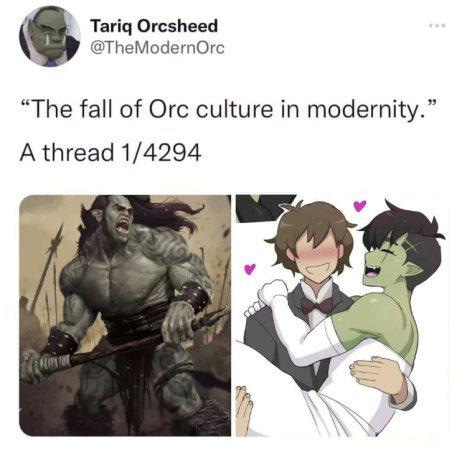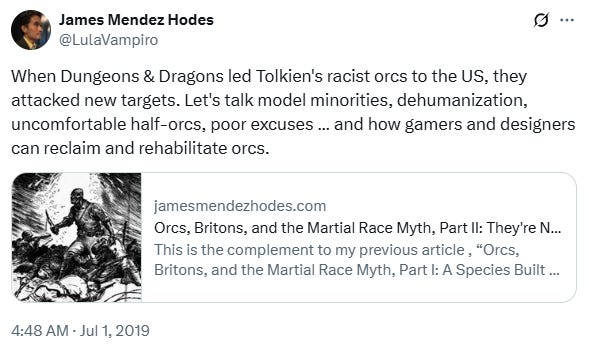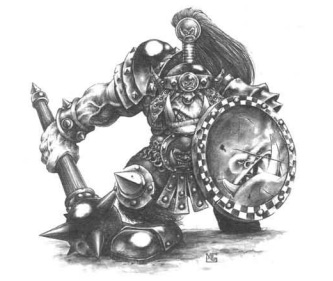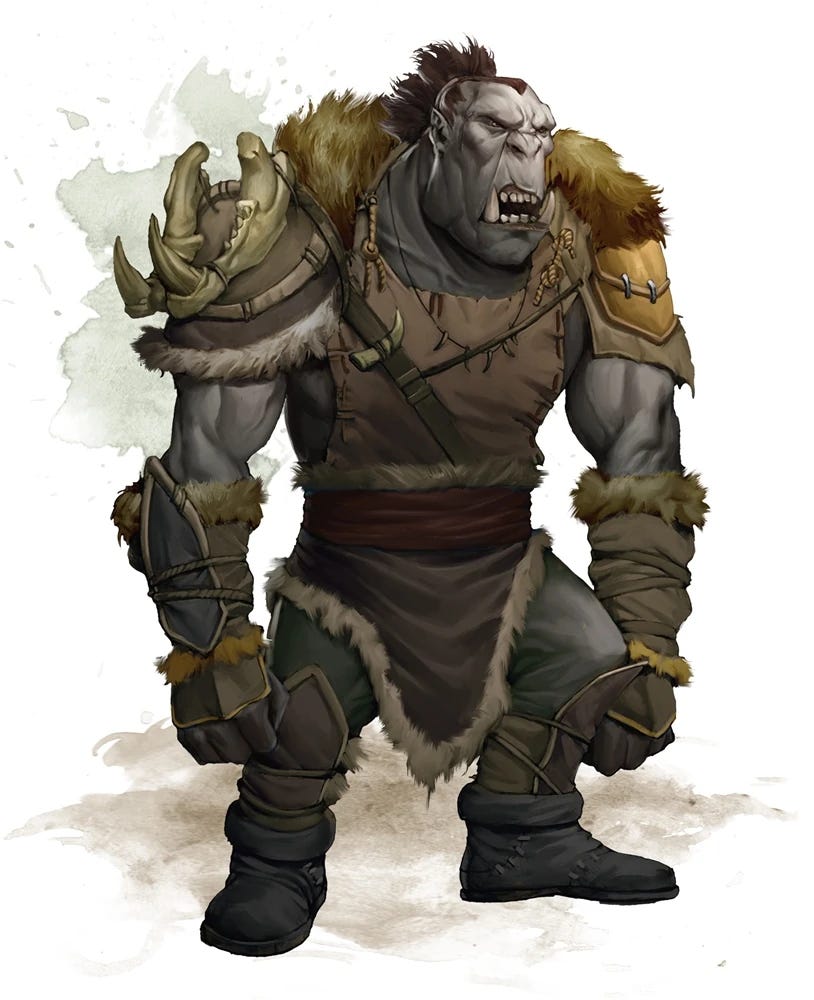This text is an appendix to a very long article about the history of woke D&D. That longer text was very fun to write and as so often happens when one is having fun in writing, things spiraled away from the original intent I had when starting the writing process. My original intent (I think, not sure, can’t really remember) was just to do a summary of the series of events that make up the history of woke D&D. Even though this is an appendix, I’ve tried to structure it so that it should be able to stand on its own as a shorter article summarizing the series of events that make up the history of woke D&D. This means that some text from the longer main article reappears here. If readers want to read the longer article first, then treat this as a bonus. If readers want to read this first to prepare themselves for the longer article – whatever, that’s up to them. If you’re completely unfamiliar with the phenomenon of woke D&D though, I advise you to watch this video before reading on.
Who are these two old white guys apologizing for their game having been created by old white guys? Isn’t it a bit disrespectful to the guys they have to thank for their careers? Isn’t it a bit disrespectful to themselves, self-flagellating like this? Why would you talk down your own brand like this? To find out, you’ll have to read the main article (sorry about that, I promised this was gonna be self-contained, guess I lied) but if you want more of these kinds of absurdities, you’ve come to the right place to scratch your itch.
Games journalism website Polygon reported on an announcement by WotC on June 17 called “Diversity & Dungeons & Dragons” about, “adressing racist stereotypes in D&D.” In the statement WotC declared that appropriate representation of different (real-world) ethnicities, gender identities, sexual orientations and beliefs would be a priority moving forward, as they had up until now (to the surprise of many of the games long time players, I’d expect) only focused on depicting “fantasy versions of North Europeans”.
Objectively evil races such as the Drow (dark elves) and Orcs are described as “problematic” as the way they are depicted supposedly empowers essentialist (biological or otherwise) notions of real-world human ethnicities. It is also heavily implied that the Drow and Orcs are especially hurtful as they have, up until now, acted as stand-ins for different non-European ethnicities. Whether WotC means that western sub-ethnicities, such as afro-americans, also find their stand-ins in races such as orcs is not entirely clear in this post. They do however claim that “some of the peoples in the game—orcs and drow being two of the prime examples—have been characterized as monstrous and evil, using descriptions that are painfully reminiscent of how real-world ethnic groups have been and continue [my emphasis] to be denigrated.” So it’s clearly not only historic cultures such as nomadic North American Indians they are referring to. Whatever is the case, many have made the connection to American blacks, such as WotC-hired sensitivity and cultural consultant James Mendez Hodes.
Finally, WotC stated that they will from now on work with a variety of “sensitivity readers” on future content and continue relying on “experts in various fields to help us identify our blind spots.” The publisher added that it is “seeking new, diverse talent to join our staff and our pool of freelance writers and artists.”
Mendez Hodes doesn’t prove any connection between orcs and American black people at all in his article but just operates from the assumption that as J.R.R. Tolkien’s orcs came to America through D&D they were mutated from, what Mendez Hodes correctly identifies as, a stereotypical depiction of orcs as mongols into being representative of black people. Proof that they are representative of black Americans is that words like “Horde. Terror. Tribe. Barbaric. Savage” are used to describe half-orcs in the D&D 5th edition’s Player’s Handbook released in 2014, as well as being visually depicted as "swole". It's kinda weird that Mendez Hodes immediately associates this description with black Americans, a population who through its entire recorded history have never lived in tribes or outside of civilization and it’s kinda weird he claims that as the concept of the Orc migrated to America, the creators of D&D (consciously or unconsciously) turned them into representations of American black people, because what they actually depicted them as probably isn’t what Mendez Hodes thinks it was.
The orcs as they were depicted in Gygax 1st edition of D&D were guys with pigs heads who were not particularly swole and in the Monsters Manual of the 2nd edition they were depicted sort of like scrawny, toadish guys with snouts. The depiction of them as, still pig-ish, more muscular brutes didn’t become a thing until Monster Manual of the 3rd edition and this was in the year 2000, well after the 1993 release of the british Warhammer Fantasy game’s (produced by Games Workshop, an entirely different company from D&D's publishing company Wizards of the Coast) release of the “Orcs & Goblins Army Book (4th Ed)” product and 1994 release of Warhammer 40k:s (the sci-fi version of the game) “Codex: Orks (2nd Ed)”. These products were the first to depict orcs as particularly swole, as hulking brutes even, as well as cockney speaking working class british football hooligans (a stereotypically white demographic) in the way they spoke and in some mannerisms. Perhaps more importantly, the 3rd edition depiction of orcs was 6 years after the release of the first Warcraft game, which started out as basically a Warhammer rip-off including the way they designed the orcs, which in turn launched a hugely popular series of fantasy whose depictions of orcs has become hegemonic. This can for example be seen in how the D&D 4th edition and pre-woke 5th edition orcs look pretty much exactly like Warcraft orcs (who by the way are depicted more as native american noble savages since having been depicted as more than generic bad guys in the third Warcraft game released in 2002).
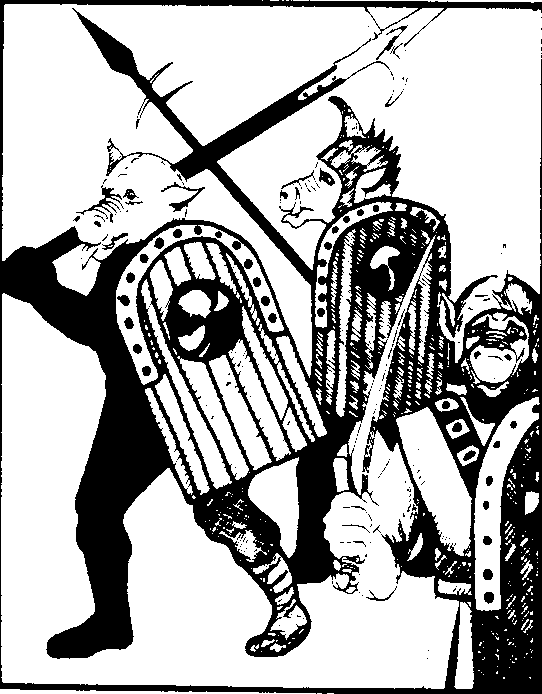



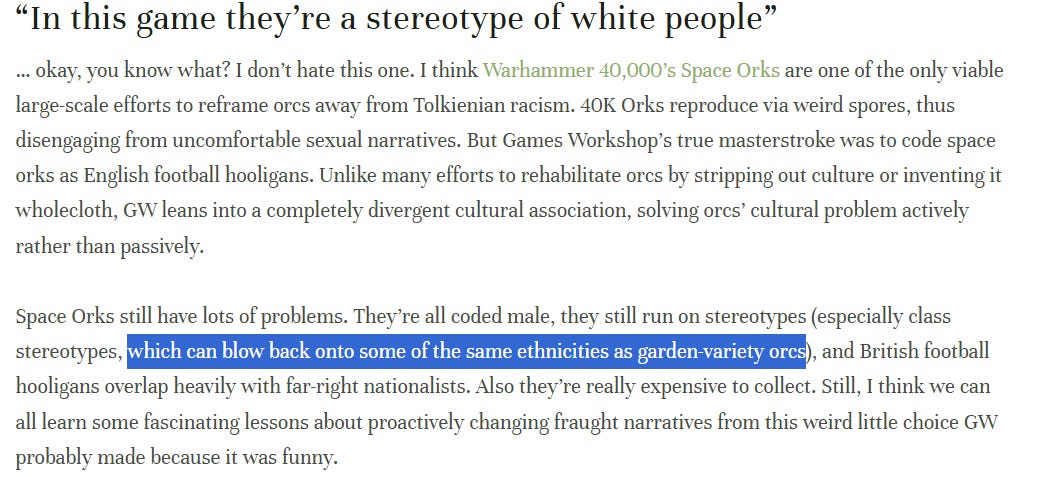



It’s almost as if Mendez Hodes has no idea what he’s talking about. But surely, a professional cultural consultant in the RPG industry, an expert on fantasy racism, would know his fantasy racial stereotypes?

Ehrm… Well maybe not then. Despite selling his services as a professional anti-racist3 game developer since at least 2015 and anti-racist cultural consultant4 since at least 2018, he seems to have had no idea what the foundational One Fantasy Racial Stereotype to Rule Them All was until having to look it up after deciding to write about how racist it is.
Okay, okay, okay – maybe this guy isn’t very well-versed in Tolkien, but whatever, he’s probably read up on theory and can deploy that to deconstruct whatever trope he comes across, even if he has to read up on it first. This is why he’s structured his article after quotes from Frantz Fanon’s seminal postcolonial work “The Wretched of the Earth”, after all. It’s a little weird that he keeps quoting just the foreword by Jean-Paul Sartre but I’m sure that’s ju-
Oh… Oh no…
Anway, whatever WotC meant by saying that “real-world ethnic groups have been and continue to be denigrated”, the idea that black Americans were denigrated by the depiction of orcs in WotC’s products has become an accepted truth in woke circles and by WotC. Mendez Hodes is just that good.
This, the June 1 and June 17 2020 statements were followed by a slew of products sprinkled with “cultural sensitivity”. Other than the (in-/)famously wheelchair accessible dungeon of “Candlekeep Mysteries”, released in 2021, “Spelljammer: Adventures in Space” had to be immediately revised after its release in August 2022 due to the “Hadozee controversy”. Polygon’s recounting of and comments on Hadozee lore follows: “”The first Hadozees were timid mammals no bigger than housecats. Hunted by larger natural predators, the hadozees took to the trees and evolved wing-like flaps that enabled them to glide from branch to branch.” From there it tells the tale of a wizard who trapped and effectively enslaved these creatures with the intent of selling them “to the highest bidder.” Eventually, the wizard’s apprentices befriended these hadozee and set them free.” Following the release, according to Polygon, “fans on social media [pointed] out the parallels to the Black experience, and the history of slavery in the United States and abroad — including the setting’s reliance on antiquated sailing ships, the same kinds of vessels that brought enslaved people to North America in the first place. Critics [had] also found images in the book that hearken back to racist minstrel shows.” No examples are given of the harkening back to minstrel shows, of course, and the article does not develop on how “things really go off the rails”, as the article states it does, in the Forgotten Realms wiki article on the Hadozee. Having read the Spelljammer publication in question and the wiki article myself, I can at least say that I didn’t really notice any minstrel shows, blackface or even references to real world africans, unless one immediately identifies slavery and monkeys in trees with real human africans. A racist mind is a racist kind, one might be tempted to say. Whatever the case, in September 2022 WotC issued an apology, removed all references to the Hadozee in digital copies of the books and stated that they had initiated an “internal review of the situation and will take the necessary actions as a result of that review”.

In July 2022, WotC released “Journeys Through the Radiant Citadel”, another compilation of adventures much like “Candlekeep Mysteries”. This is the first adventure anthology, to my knowledge, which has credited several “cultural consultants” and it’s pretty clear that this release was launched as a flagship for the new and inclusive or woke, whichever you prefer, D&D. The lead designer of the anthology, Ajit George, said, as reported by Polygon, during a presentation for the press that “I couldn’t shake the idea of a whole book written by Black and brown writers inspired by their own cultures, myths, and stories. I pitched the idea of a book [filled with] lands and cultures inspired by their own lives, background, and history.” And true enough, all the adventures in the book are written by non-white Americans, as a direct callback to the promises of filling the WotC staff with more “diversity” in the wake of the BLM protests of 2020. Along with the credited cultural consultants, most of the writers give explicit expression to (in the “Writer interviews”) a worldview where social categories (certain races, genders, sexualities etc.), which they as writers are representatives of, outside the supposed hegemonic culture (“white”, “eurocentric”, “patriarchal”, “cis-gendered” and so on) have a particular point of view allowing them to better, or exclusively, understand certain facts about their own marginalization. This worldview is what I would define as the meaning of “woke”, but more on that in the main article.
The many adventures of the Radiant Citadel have their point of departure in a magical floating city in dream-space (“the ethereal realm”, for those who play) founded and inhabited by refugees from several different cultures all inspired by non-european and non-majority white (in the north american sense of the word) areas of America to which the writers of the adventures have some sort of generational relationship to, an explicit selling point in the marketing of the book. The citadel itself is governed as a sort of utopia based on the ideology of Black Lives Matter (the liberal lobbying organization, not the spontaneous protest waves of black Americans voicing concerns with american policing). The police is abolished, fantasy social workers “care” for criminals and when the social care is not enough “the worst offenders are sentenced to a controversial Djaynaian punishment wherein the criminal is subjected to a ritual that prevents them from repeating their crime and then is banished from the city”, in a wonderfully crypto-Stalinist brainwashing fashion. The political system is based on ethnic corporatism and on the “consensus” of a council formed out of representatives of ethnic groups. The multiculturalism of the citadel is described as tricky to govern but the diversity is a strength, never described as a weakness in any meaningful sense. Cultures intermingle and produce different kinds of exciting ethnic foods and the citadel is thankfully never plagued by racist attitudes, demagoguery based on racial grievances, race riots or anything of the sort, unlike most real world multicultural societies where even the most well functioning ones aren’t free from the more unsavory effects of multiculturalism. The Radiant Citadel is probably the most poignant and the most funny expression of woke culture in D&D, but perhaps not the most important.
More importantly, in november 2022, WotC published a new post titled ”Leveling Up Our Creative Process: Learning From Spelljammer”. This post described the ”inclusivity reviews” WotC had begun implementing to avoid future controversies like the Hadozee one. In short, these reviews mean that “the studio’s new process mandates that every word, illustration, and map must be reviewed by multiple outside cultural consultants [my emphasis] prior to publication”. The new inclusion-review process applies to not only products in development but also reprints. In other words, every reprint is an opportunity to conduct a new inclusion review on previously published content. As WotC are increasingly releasing their products as living digital documents, this means the products can be revised whenever for whatever reason and content present at the point of paying for access to the product might disappear forever – a sort of Djaynaian ritual punishment for past misdeeds. What, then, is the theme of these revisions from this new cultural and sensitivity review regime ruling over D&D-fandom?
In November 2023 a very interesting blog post was released. In “What we can learn from WotC’s Core Book Sensitivity and Inclusivity Changes”, Teos Abadía (professional Environmental and Health Consultant as well as part time WotC published game designer) details the sensitivity and inclusivity changes from what core rulebooks for 5th edition D&D were like when they were released in 2014 to how they appear now (in november 2023) in the mobile app for the game. As Abadía explains, only a minority of the changes have been technical or grammatical while the vast majority of the changes were around sensitivity and inclusivity. Abadía considers these changes as a part of “decolonizing games”. According to Abadía, what makes roleplaying games, among other things, colonial, in this sense, is that they have historically “portrayed non-Western cultures and non-urban areas as lesser.” An expression of this colonialism in RPGs is “the barbarian who wears animal skins and is portrayed as uneducated” and “the quest to tame the dangerous wilderness and any sentient creatures dwelling there”. But is this really colonialism? Barbarians, of whatever non-Greek speaking variant they were such as Germans, Slavs or Bedouins, were in fact, and not only in colonialist stereotypes, quite often clad in animal skins and possessed little to no formal education. “Taming of dangerous wilderness” goes with agriculture as such and while one might define colonization as the settlement of any land, inhabited or not, it’s usually not the struggle against permanent residence in general that the term “decolonization” is associated with. All this is just to say that Abadías, and WotC’s, concept of “decolonization” is pretty confused even on its own premises.
Abadía goes on to describe and discuss changes in the books regarding sensitive themes or terms such as Savagery and Civilization, Madness, Insanity and the word "Crazy", Bioessentialism, Racial Purity, Comparisons of Lesser races, Low Intelligence as a Species, Gender, using "Blindness" in a figurative sense to describe someone being unaware, the word "Fat", Asian cultures association with honor, Phylacteries, Slavery and Darkness. Some of these are rather ridiculous at face value, such as describing ogres as “fat” apparently being so insensitive that Abadía deems it appropriate to celebrate the sensitivity of WotC instead calling ogres “well-fed”. There’s enough finger-wagging and anti-bullying discourse of the grade school variety in Abadías article, as there is in most cases of woke language policing, to fill a rather long catalogue. This makes Abadías compilation of changes a strong reference point which we’ll be coming back to in this article but we won’t have the time to deal with every identity based grievance and will mostly focus on the bigger cultural issues such as claims made about civilization/barbarism, essentialism/social constructivism and so on. This is because I believe these themes to be the most relevant ones not of wokeness in general but of woke D&D in particular. I also believe that Abadía is entirely correct in that decolonization, as that term is understood in the academic fields of post-colonialism and decoloniality,5 is the core of woke D&D.
There are numerous other events and product releases that relate to the phenomenon of “woke D&D”. I’ve probably missed some of it (making this history only near-comprehensive, sorry again for the false advertising) but I’m going to list the ones I find the most interesting and the most important for painting a full picture. I do however like the idea of writing a 100% comprehensive history of this stuff so I might come back to this text in the future.
Matt Mercer and his “Critical Role” podcast (a podcast featuring professional voice actors playing D&D, albeit under what on suspects to be pretty scripted circumstances) has had a huge influence on the current subculture around D&D. I haven’t listened all too much to the show but it is clearly “left liberal” in its tone and has been awarded, probably not in due small part to this tone, with several book deals with WotC where Mercer's own adventures and settings get a professional treatment, for example the WotC published adventure “Critcal Role: Call of the Netherdeep” (May, 2022) which of course has a cultural consultant credited at the end of the book. I’m sure the show could be entertaining, I have limited insight into it, but what is important to note is that Matt Mercer was already employing “cultural and sensitivity consultants” for the writing of his campaigns before the publication of “Call of the Netherdeep” but has still been the target of criticism of implicit racism. It is interesting how Mercer’s critic (Jenna Yow, a professional “narrative designer”) chooses to end her article: “You can’t act as a company but expect to be forgiven like a person. If content creators like the members of Critical Role continue to profit at this scale, they have to understand that they will become beholden to public opinion.” Who helps shape public opinion on games like these? Perhaps a narrative designer, helping one to avoid the pitfalls of insensitive faux-pas? Perhaps even more sensitivity consultants? Whatever professional is needed, I’m sure Ms Yow is up for the task if called upon. And if not, you know, it’s a nice show they got there, shame if something happened to it.
Some products released under the cultural and sensitivity review regime have no credited consultants, but still bear the mark of the regime.
“Candlekeep Mysteries” (16 March, 2021) has no credited consultants but is nevertheless the home of professional “consultant” and “disability advocate” Jennifer Kretchmers’ wheelchair accessible dungeon, a dungeon and adventure which was explicitly marketed on woke grounds, as described in the introduction of this article. It is also the home of contributions by writers such as Graeme Barber who describes himself as “a lapsed academic” known for texts criticizing “colonial perspectives” in D&D products (and to a lesser degree known for his NATO deployments to Bosnia and Afghanistan, a true anti-colonial effort!), so much so that he distanced himself from his own contribution to Candlekeep due to “Colonialist language and imagery around the Grippli[, a race of frog people,] was inserted [in the final product] as well, moving them from being simple and utilitarian with obvious culture and technology to being ‘primitives’ who ‘primitively decorate’ their thatched huts with crab bits.” We also have Daniel Kwan, famous for so effectively criticizing the AD&D 1E Oriental Adventures book still being sold online, even though it was supposedly an orientalist (a negative term in the post-colonial sense, se the seminal postcolonial work “Orientalism”, by Edward Said) book, that it resulted in WotC adding disclaimers to all of their old PDF products and Kwan earning an award. I could go on, but I think this is enough to prove that even when the explicit wokeness is not obvious at a quick glance, looking for it in writers and designers is like trying to hit the broadside of a barn.
Also worth mentioning is that behind the scenes, Jontelle Leyson-Smith was hired as the companies first ever Director of Diversity, Equity, and Inclusion in as early as December 2020, according to her LinkedIn (while it was officially announced on February 2, 2021). With this position filled, we can perhaps assume the inclusivity review regime to be ever present, even in addition to or in the absence of credited cultural or sensitivity consultants or other details revealing an inclusivity review having been implemented. Leyson-Smith quit her position in January 2024, but as Sameer Joseph (also a credited cultural/sensitivity consultant who we will be returning to below) was hired as “Associate Project Manager DE&I, Philanthropy, and Employee Experience” in July 2023 and still holds this position, which entails being a product reviewer in relation to DEI, maintaining and enforcing the inclusion review process and being an “employee resource group advocate” (whatever that last one means), it is clear these woke managerial roles exist and rule over the inclusivity review regime as a whole. These two are people appearing in news, company statements and who have open LinkedIn profiles and there might be more people like them at the company, although I haven’t been able to find any public information on that. These people are not very public about their theoretical outlook or worldview, but we can rely on the general spirit of the review process, as described by Teos Abadía above, to get an idea of what woke commissars like Leyson-Smith and Joseph se as their mission: “decolonizing games”, in Abadías words.
If you liked this, you should probably check out the main article or Appendix C which goes through who all these woke consultants and managers of the cultural and sensitivity review regime actually are. You could of course also check out Appendix B but that’s just a summary of two letters. It’ll make more sense if you read the main article.
There are also illustrations of what I think are supposed to be orcs (it’s honestly hard to tell with some of them) on p. 86, p. 108, p. 123, p. 124, p. 136, p. 186 and p. 189.
Under “Monster Conversions” towards the end of the revised Monster Manual it says “Every monster in 2014 Monster Manual either appears in this book or has a CR-appropriate replacement. If you're using material published prior to this book and are unable to locate a stat block herein, consult the Stat Block Conversions table to find the equivalent stat block you should use.” Orcs have been converted to “Toughs”, a non-specified “tough” humanoid.
“I wrote Thousand Arrows because I wanted a role-playing game about Asian people and themes written in my native language, but not for the white gaze.” – from “Thousand Arrows and Sensitivity, Part I: the Core Game”, an article on a game he made.
“The Giant Robot of Offense is a framework for creating content which won’t harm people. I use it for role-playing games, but it applies to any media which generate participatory elements (including cosplay and fanfiction). Think of your creation as a giant badass anime robot you’re building. Here’s how to make media, and/or build a robot, which won’t harm anyone except for bad guys in giant rubber suits.” – from “The Giant Robot of Offense”, an article consulting people on how to design games.
Decoloniality is basically not at all distinct from postcolonialism when it comes to general frame of analysis. It mainly differs in that decolonialitiy’s object of analysis is first and foremost the relationship between pre-colonial and colonial America and in that decoloniality usually makes direct political claims about having to culturally or psychologically “decolonize” this or that. The general discursive and historical method used by Edward Said, in his seminal postcolonial work Orientalism, to identify cultural and psychological colonialism remains, however, as does the psychological elements of Fanon as presented in his “The Wretched of the Earth” and “Black Skins, White Masks”. I bring up the distinction just to make clear that whenever decoloniality and not postcolonialism is used as a term, they should be considered to be interchangeable terms in regards to theoretical basis.




